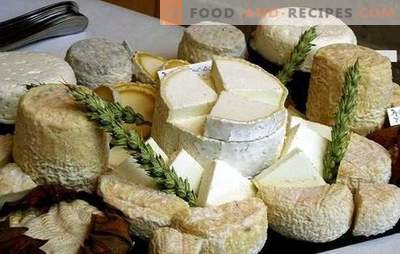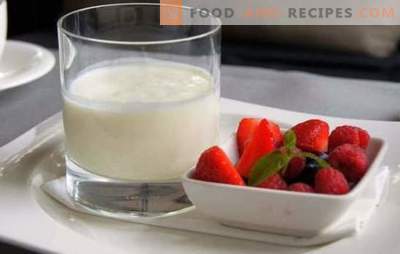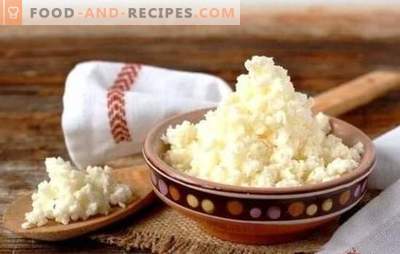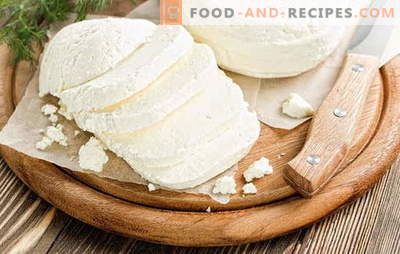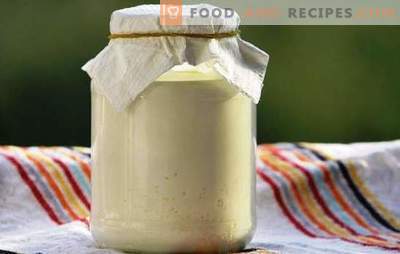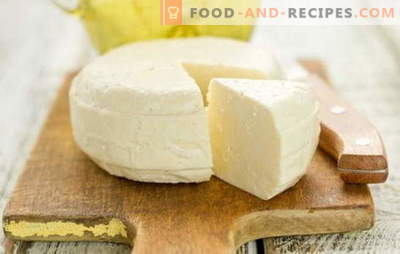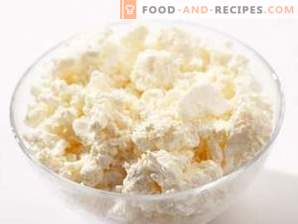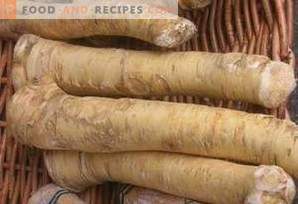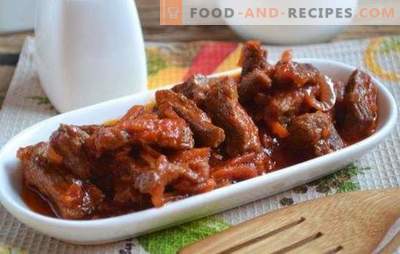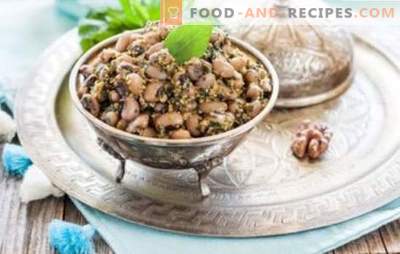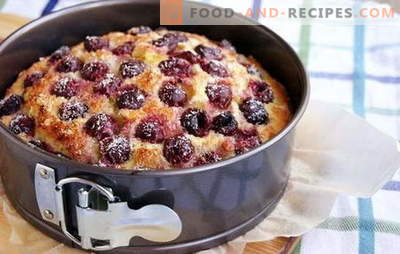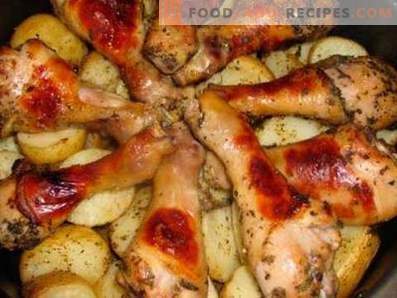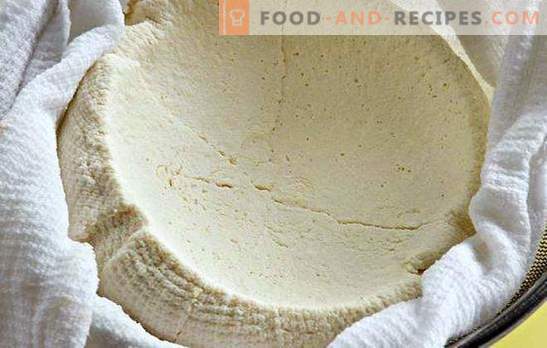
When it comes to cottage cheese, there is a long row on the collective farm market with cans of sour cream, bottles of milk, fresh butter and large basins, pots, plastic containers of cottage cheese: oily with a creamy tint, snow-white with small grains of grain, medium - Milk abundance for every taste.
The same picture, but near the dairy supermarket showcase, for some reason, does not cause such an appetite, despite the colorful packaging, a clear, geometric display of goods and neat, smiling saleswomen. You take a pack of cottage cheese, and parchment packaging is sticky! Or, no, not so. You take a plastic jar with cottage cheese in your hands, and it says that the shelf life is 2 weeks, and this is not the most awesome variant of the inscription. You come back home with the firm confidence that you are carrying “a cat in a bag” for dinner. Natural dairy product can not be stored for more than 3 days. Of course, not everything is so terrible. It happens that carries: and the manufacturer is conscientious, and the seller is interested in attracting buyers.
But in the market they will give and try, and they will tell about life and time, and, in between times, you can find out in what meadow a cow grazed, from which milk the curd was made, what it was fed and when it was vaccinated. Here, this is a real choice, as they say, with taste and sensibly. Good homemade cottage cheese - always in great demand. If they were late, and it ended - not scary. Milk is still left, and village women are always in a hurry to return home early - they have a large farm, a lot of work. Therefore, having bargained and having bought 5-10 liters of milk, you will also win and win - you will definitely lose in price. We return home, and begin to conjure, or rather to create: this very word is etymologically linked to the word “curd”.
Home-made curd from sour milk - preparing raw materials
Raw materials, in this case, is called milk, bought on the market. We do not consider the options for cooking cottage cheese from milk purchased in the store, since even natural whole milk, but in the original packaging will not give the desired result. Under production conditions, milk undergoes mandatory pasteurization at high temperature. As a result, low-quality dry curd grain is obtained from such milk. Homemade cottage cheese production is different from industrial ways of processing milk. Pasteurization of milk occurs at a temperature of 630 ° C (long-term processing) to 900 ° C (instant pasteurization). Lactic acid bacteria die at 37-450C. That is, after warming the milk its fermentation becomes impossible in a natural way. In addition to the fact that during high-temperature processing, milk loses almost all valuable vitamins and amino acids, it loses its ability to coagulate, and it is this quality of the product that underlies the preparation of cottage cheese.
But what about sanitary standards and how to cook cottage cheese from yogurt at home to get a natural product and, at the same time, protect yourself from pathogenic microbes?
The answer to this question lies in the ability of lactic acid bacteria to produce lactic acid. Raw cow's milk contains 96% of harmful microorganisms and 4% of lactobacilli, but these four percent are enough to create an acidic environment and destroy pathogenic microorganisms.
If it is so easy to get rid of harmful organisms, then why is the milk being pasteurized in factories? Everything is simple. Milk tons are brought to dairies, it is collected on farms and in private farms, merging everything together into large tanks. With such volumes, it is difficult to keep track of the purity of the raw materials, especially since milk is a perishable product and it is necessary to bring it for processing quickly. The housewife also buys milk from one seller. It was not by chance that at the beginning of the article, personal contact with the seller on the market was mentioned in such detail.
What else is the process of preparing milk and how to cook cottage cheese from yogurt at home?
Depending on the fat content in milk, cottage cheese may also be of different fat content. In whole milk can contain up to 30% fat. Therefore, if you want to cottage cheese was dietary (fat-free) or bold, then you need to remove the cream. Let the milk settle in a glass bottle so that the fatty particles float to the surface. To remove the cream at home is convenient in the following way: a plastic tube is inserted into the bottle with the settled milk (a tube from a medical system for drip injections will do). The tube should touch the bottom. Lower the second end into another container located at a lower level than the bottle. Pump the milk to another container until only the fat part remains in the bottle. You can make sour cream from the cream, and skimmed milk, leave the saucepan for souring and further cooking of cottage cheese. In this preparation of milk for cooking homemade curd from yogurt is over. We now turn to the question of the main technological points of obtaining cottage cheese.
Home-made curd from sour milk - souring milk
Milk will turn sour in and of itself, if you put the container for several hours in a warm place. Then what are we talking about? That it is possible, for example, to speed up this process.
Fresh milk to get yogurt (cottage cheese cannot be obtained without this product) is added for souring:
Lemon juice or citric acid solution - one tablespoon per liter of warm (25-370C) milk;
Sour-milk products - sour cream, kefir, already prepared yogurt, natural yogurt. Milk is also pre-heated in order to create the most favorable conditions for the life of lactic acid bacteria;
Special starters - they can be purchased at a pharmacy or specialized points of sale (acidophilus, atsedin-pepsin, “Lactone” and others). They are added to milk according to the attached instructions for use.
Sour milk is ready, only this is half the battle. We turn to the main goal - to get cottage cheese from it.
Homemade cottage cheese from yogurt - the main technological moments
First you need to know that milk is approximately 80% water, and only 20% are solid substances. From here - from a liter of milk you can get no more than 200 g of cottage cheese, and if the milk is skimmed, then the weight of the finished product decreases in proportion to the proportion of fat in the milk composition. As you know, the fat also consists of water and retains moisture, which means that the cottage cheese made from skimmed milk will be dry, with less whey content. As they say, it's a matter of taste, but if you need to get low-fat cottage cheese with a sufficient degree of moisture, you must strictly follow the technological aspects.
The fermented milk needs to be heated, but not overheated, so that the milk protein does not curl up to the rubber consistency. While warming the sour milk, you need to constantly stir the mass in order to ensure uniform heating. The temperature of heating at home is rarely determined with a thermometer, but approximately the separation of milk protein begins at 500 ° C. At this time, the solid mass begins to rise to the surface of the pan. In order not to overdry the cottage cheese, turn off the stove and cool the whey together with the formed clot to 20-250C. After you can start pressing. It is very convenient for this purpose to cover with a gauze a colander installed above the tank for draining the whey. Pour the contents of the preheated pan through a colander. Part of the serum will drain immediately, easily separated from the clot. The whey remaining in the almost finished cottage cheese is separated by pressing, controlling the moisture content of the finished product at its discretion. To do this, tie the ends of the lined gauze and hang the curd over the dishes to further drain the liquid. In the same way, but with the use of oppression, rennet cheese is obtained: the cottage cheese tied in a gauze napkin is placed under the oppression in order to obtain pressed cottage cheese. This is the easiest way to get homemade curd from yogurt, known to humanity not one hundred, but maybe even a thousand years. Well, of course, I want, as always, diversity. Then we apply more complex, but interesting options to the main recipe.
Recipe 1. Curd mass, fruit
Composition:
- Forest berries (in assortment) 300 g
- Low-fat cottage cheese 700 g
- Fructose 250 g
- Water 100 ml
Preparation Method:
Strawberries, raspberries or other berries of your choice, pour fructose and wait until the juice separates. Mash them, add water and boil for 5-10 minutes. After cooling the fruit mass, wipe it through a sieve to remove the seeds and peel. Beat cottage cheese with a blender, gradually pouring in fruit syrup.
Recipe 2. Cheese, vanilla with raisins - a favorite taste of childhood
Composition:
- Cream
- Curd
- Sugar
- Vanillin, crystalline
- Raisin, light
Preparation:
If the cottage cheese is greasy and moist, then it is not necessary to add cream. Moisturize the dried curd grain with cream (10-15%). Proportions choose at their discretion. We combine all the components in a blender, and add the raisins at the end, into the whipped and lush curd mass, and mix it thoroughly.
Recipe 3. Cottage Cheese Snack, Spicy
Composition:
- Cherry 10 pieces
- Cottage cheese 200 g
- Garlic 10 g
- Basil, red
- Parsley
- Salt
- Ground hot pepper
Preparation:
Wash the tomatoes, cut off the part with the stem. You can make it beautiful, zigzag line. Spoon core with seeds. Finely chop the greens, rub the garlic on the finest grater. Put the curd in the blender bowl (it is better to use fat), add the prepared greens and spices. Smash into the pasta and stuff the tomatoes. On top of the stuffed vegetables, put the caps with tails.
Home-made curd from curdled milk - useful tips and tricks
- Cottage cheese too sour or too dry can be corrected. Pour into the pan fresh whole milk and heat it to 35-400C. Put the cottage cheese in the warmed milk, which requires improvement and leave for 10-12 hours. After strain through gauze.
- For long-term storage, cottage cheese can be frozen, but first put it in portions in containers and seal it tightly. Immediately after thawing, cottage cheese should be used. Repeated freezing will turn it into useless biomass.
- Cottage cheese for storage can be salted. This method of storing cottage cheese was used by our ancestors. If you then need to prepare a dish of sweet curd, then it can be washed with water and squeeze.

